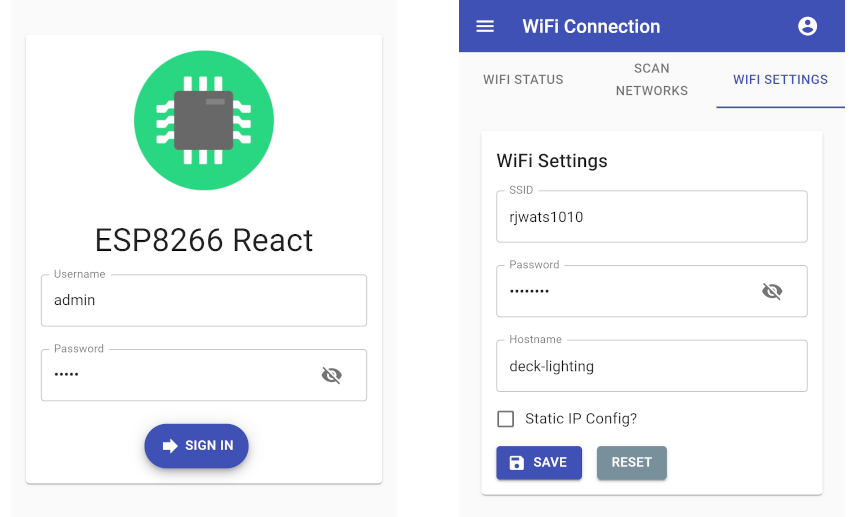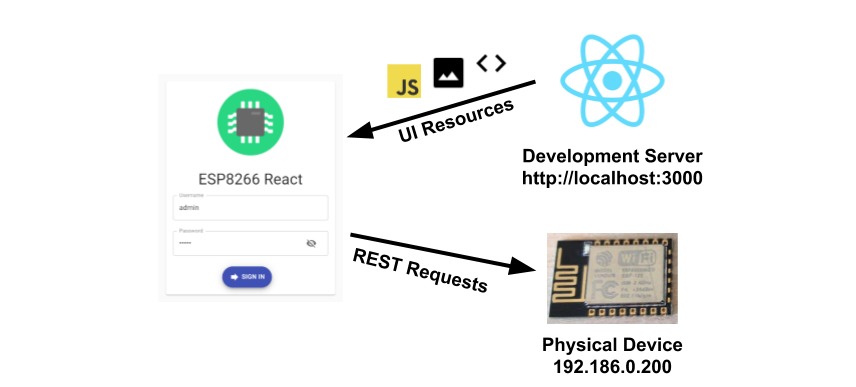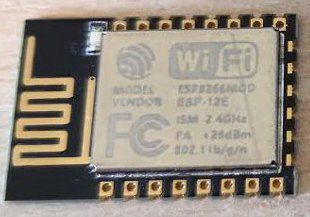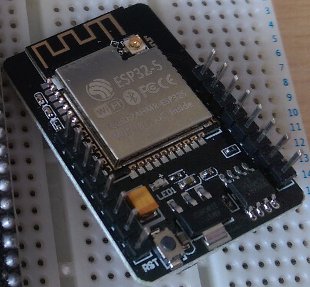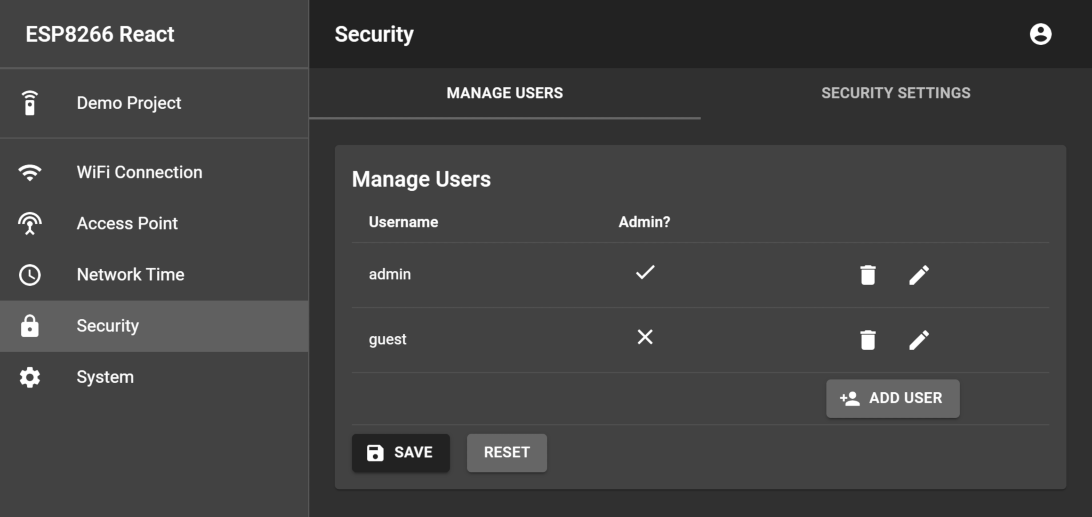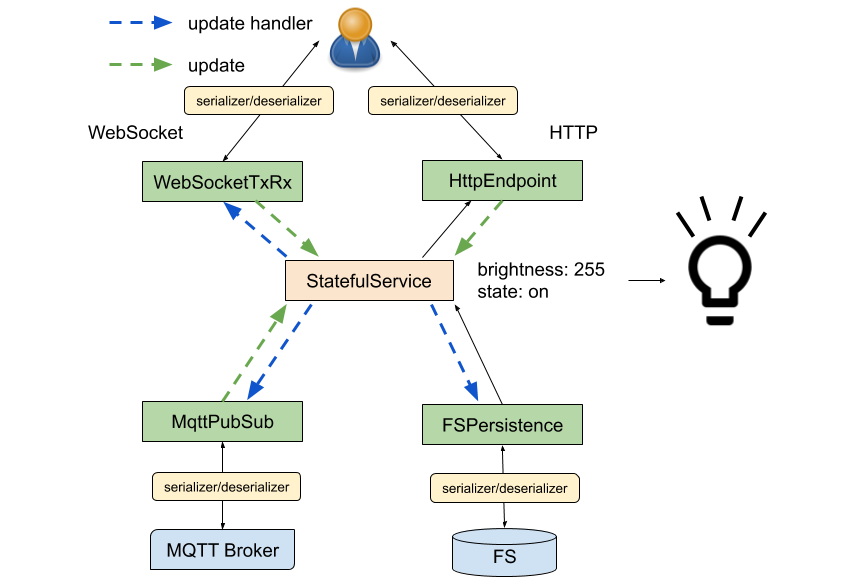28 KiB
ESP8266 React
A simple, secure and extensible framework for IoT projects built on ESP8266/ESP32 platforms with responsive React front-end built with Material-UI.
Designed to work with the PlatformIO IDE with limited setup. Please read below for setup, build and upload instructions.
Features
Provides many of the features required for IoT projects:
- Configurable WiFi - Network scanner and WiFi configuration screen
- Configurable Access Point - Can be continuous or automatically enabled when WiFi connection fails
- Network Time - Synchronization with NTP
- MQTT - Connection to an MQTT broker for automation and monitoring
- Remote Firmware Updates - Enable secured OTA updates
- Security - Protected RESTful endpoints and a secured user interface
Features may be enabled or disabled as required at compile time.
Getting Started
Prerequisites
You will need the following before you can get started.
- PlatformIO - IDE for development
- Node.js - For building the interface with npm
Building and uploading the firmware
Pull the project and open it in PlatformIO. PlatformIO should download the ESP8266 platform and the project library dependencies automatically.
The project structure is as follows:
| Resource | Description |
|---|---|
| interface/ | React based front end |
| lib/framework/ | C++ back end for the ESP8266/ESP32 device |
| src/ | The main.cpp and demo project to get you started |
| scripts/ | Scripts that build the React interface as part of the platformio build |
| platformio.ini | PlatformIO project configuration file |
Building the firmware
Once the platform and libraries are downloaded the back end should successfully build within PlatformIO.
The firmware may be built by pressing the "Build" button:
Alternatively type the run command:
platformio run
Uploading the firmware
The project is configured to upload over a serial connection by default. You can change this to use OTA updates by uncommenting the relevant lines in 'platformio.ini'.
The firmware may be uploaded to the device by pressing the "Upload" button:
Alternatively run the 'upload' target:
platformio run -t upload
Building & uploading the interface
The interface has been configured with create-react-app and react-app-rewired so the build can customized for the target device. The large artefacts are gzipped and source maps and service worker are excluded from the production build. This reduces the production build to around ~150k, which easily fits on the device.
The interface will be automatically built by PlatformIO before it builds the firmware. The project can be configured to serve the interface from either PROGMEM or SPIFFS as your project requires. The default configuration is to serve the content from PROGMEM, serving from SPIFFS requires an additional upload step which is documented below.
Serving the interface from PROGMEM
By default, the project is configured to serve the interface from PROGMEM.
Tip
: You do not need to upload a file system image unless you configure the framework to serve the interface from SPIFFS.
The interface will consume ~150k of program space which can be problematic if you already have a large binary artefact or if you have added large dependencies to the interface. The ESP32 binaries are fairly large in there simplest form so the addition of the interface resources requires us to use special partitioning for the ESP32.
When building using the "node32s" profile, the project uses the custom min_spiffs.csv partitioning mode. You may want to disable this if you are manually uploading the file system image:
[env:node32s]
board_build.partitions = min_spiffs.csv
platform = espressif32
board = node32s
Serving the interface from SPIFFS
If you choose to serve the interface from SPIFFS you will need to change the default configuration and upload the file system image manually.
Disable -D PROGMEM_WWW build flag in 'platformio.ini' and re-build the firmware. The build process will now copy the compiled interface to the data/ directory and it may be uploaded to the device by pressing the "Upload File System image" button:
Alternatively run the 'uploadfs' target:
platformio run -t uploadfs
Developing the interface locally
UI development is an iterative process so it's best to run a development server locally during interface development (using npm start). This can be accomplished by deploying the backend to a device and configuring the interface to point to it:
The following steps can get you up and running for local interface development:
- Enable CORS in platformio.ini
- Deploy firmware to device
- Configure endpoint root with device's IP in interface/.env.development
- Start the development server with "npm start"
- Develop interface locally
Enabling CORS
You can enable CORS on the back end by uncommenting the -D ENABLE_CORS build flag in 'platformio.ini' then re-building and uploading the firmware to the device. The default settings assume you will be accessing the development server on the default port on http://localhost:3000 this can also be changed if required:
-D ENABLE_CORS
-D CORS_ORIGIN=\"http://localhost:3000\"
Configuring the endpoint root
The interface has a development environment which is enabled when running the development server using npm start. The environment file can be found in 'interface/.env.development' and contains the HTTP root URL and the WebSocket root URL:
REACT_APP_HTTP_ROOT=http://192.168.0.99
REACT_APP_WEB_SOCKET_ROOT=ws://192.168.0.99
The REACT_APP_HTTP_ROOT and REACT_APP_WEB_SOCKET_ROOT properties can be modified to point a ESP device running the back end.
Tip
: You must restart the development server for changes to the environment file to come into effect.
Starting the development server
Change to the 'interface' directory with your bash shell (or Git Bash) and use the standard commands you would with any react app built with create-react-app:
cd interface
Install the npm dependencies, if required and start the development server:
npm install
npm start
Tip
: You can (optionally) speed up the build by commenting out the call to build_interface.py under "extra scripts" during local development. This will prevent the npm process from building the production release every time the firmware is compiled significantly decreasing the build time.
Selecting features
Many of the framework's built in features may be enabled or disabled as required at compile time. This can help save sketch space and memory if your project does not require the full suite of features. The access point and WiFi management features are "core features" and are always enabled. Feature selection may be controlled with the build flags defined in features.ini.
Customize the settings as you see fit. A value of 0 will disable the specified feature:
-D FT_PROJECT=1
-D FT_SECURITY=1
-D FT_MQTT=1
-D FT_NTP=1
-D FT_OTA=1
| Flag | Description |
|---|---|
| FT_PROJECT | Controls whether the "project" section of the UI is enabled. Disable this if you don't intend to have your own screens in the UI. |
| FT_SECURITY | Controls whether the security features are enabled. Disabling this means you won't need to authenticate to access the device and all authentication predicates will be bypassed. |
| FT_MQTT | Controls whether the MQTT features are enabled. Disable this if your project does not require MQTT support. |
| FT_NTP | Controls whether network time protocol synchronization features are enabled. Disable this if your project does not require accurate time. |
| FT_OTA | Controls whether OTA update support is enabled. Disable this if you won't be using the remote update feature. |
Factory settings
The framework has built-in factory settings which act as default values for the various configurable services where settings are not saved on the file system. These settings can be overridden using the build flags defined in factory_settings.ini.
Customize the settings as you see fit, for example you might configure your home WiFi network as the factory default:
-D FACTORY_WIFI_SSID=\"My Awesome WiFi Network\"
-D FACTORY_WIFI_PASSWORD=\"secret\"
-D FACTORY_WIFI_HOSTNAME=\"awesome_light_controller\"
Default access point settings
By default, the factory settings configure the device to bring up an access point on start up which can be used to configure the device:
- SSID: ESP8266-React
- Password: esp-react
Security settings and user credentials
By default, the factory settings configure two user accounts with the following credentials:
| Username | Password |
|---|---|
| admin | admin |
| guest | guest |
It is recommended that you change the user credentials from their defaults better protect your device. You can do this in the user interface, or by modifying factory_settings.ini as mentioned above.
Customizing the factory time zone setting
Changing factory time zone setting is a common requirement. This requires a little effort because the time zone name and POSIX format are stored as separate values for the moment. The time zone names and POSIX formats are contained in the UI code in TZ.tsx. Take the appropriate pair of values from there, for example, for Los Angeles you would use:
-D FACTORY_NTP_TIME_ZONE_LABEL=\"America/Los_Angeles\"
-D FACTORY_NTP_TIME_ZONE_FORMAT=\"PST8PDT,M3.2.0,M11.1.0\"
Device ID factory defaults
If not overridden with a build flag, the framework will use the device ID to generate factory defaults for settings such as the JWT secret and MQTT client ID.
Tip
: Random values are generally better defaults for these settings, so it is recommended you leave these flags undefined.
Building for different devices
This project supports ESP8266 and ESP32 platforms. To support OTA programming, enough free space to upload the new sketch and file system image will be required. It is recommended that a board with at least 2mb of flash is used.
The pre-configured environments are "esp12e" and "node32s". These are common ESP8266/ESP32 variants with 4mb of flash:
The settings file 'platformio.ini' configures the supported environments. Modify these, or add new environments for the devides you need to support. The default environments are as follows:
[env:esp12e]
platform = espressif8266
board = esp12e
board_build.f_cpu = 160000000L
[env:node32s]
platform = espressif32
board = node32s
If you want to build for a different device, all you need to do is re-configure 'platformio.ini' and select an alternative environment by modifying the default_envs variable. Building for the common esp32 "node32s" board for example:
[platformio]
;default_envs = esp12e
default_envs = node32s
Customizing and theming
The framework, and MaterialUI allows for a reasonable degree of customization with little effort.
Theming the app
The app can be easily themed by editing the MaterialUI theme. Edit the theme in 'interface/src/CustomMuiTheme.tsx' as you desire. For example, here is a dark theme:
const theme = createMuiTheme({
palette: {
type:"dark",
primary: {
main: '#222',
},
secondary: {
main: '#666',
},
info: {
main: blueGrey[900]
},
warning: {
main: orange[500]
},
error: {
main: red[500]
},
success: {
main: green[500]
}
}
});
Changing the app icon
You can replace the app icon is located at 'interface/public/app/icon.png' with one of your preference. A 256 x 256 PNG is recommended for best compatibility.
Changing the app name
The app name displayed on the login page and on the menu bar can be modified by editing the REACT_APP_NAME property in 'interface/.env'
REACT_APP_NAME=Funky IoT Project
There is also a manifest file which contains the app name to use when adding the app to a mobile device, so you may wish to also edit 'interface/public/app/manifest.json':
{
"name":"Funky IoT Project",
"icons":[
{
"src":"/app/icon.png",
"sizes":"48x48 72x72 96x96 128x128 256x256"
}
],
"start_url":"/",
"display":"fullscreen",
"orientation":"any"
}
Back end
The back end is a set of REST endpoints hosted by a ESPAsyncWebServer instance. The 'lib/framework' directory contains the majority of the back end code. The framework contains of a number of useful utility classes which you can use when extending it. The project also comes with a demo project to give you some help getting started.
The framework's source is split up by feature, for example WiFiScanner.h implements the end points for scanning for available networks where as WiFiSettingsService.h handles configuring the WiFi settings and managing the WiFi connection.
Initializing the framework
The 'src/main.cpp' file constructs the webserver and initializes the framework. You can add endpoints to the server here to support your IoT project. The main loop is also accessable so you can run your own code easily.
The following code creates the web server and esp8266React framework:
AsyncWebServer server(80);
ESP8266React esp8266React(&server, &SPIFFS);
Now in the setup() function the initialization is performed:
void setup() {
// start serial and filesystem
Serial.begin(SERIAL_BAUD_RATE);
// start the file system (must be done before starting the framework)
#ifdef ESP32
SPIFFS.begin(true);
#elif defined(ESP8266)
SPIFFS.begin();
#endif
// start the framework and demo project
esp8266React.begin();
// start the server
server.begin();
}
Finally the loop calls the framework's loop function to service the frameworks features.
void loop() {
// run the framework's loop function
esp8266React.loop();
}
Developing with the framework
The framework promotes a modular design and exposes features you may re-use to speed up the development of your project. Where possible it is recommended that you use the features the frameworks supplies. These are documented in this section and a comprehensive example is provided by the demo project.
The following diagram visualises how the framework's modular components fit together, each feature is described in detail below.
Stateful service
The StatefulService.h class is responsible for managing state. It has an API which allows other code to update or respond to updates in the state it manages. You can define a data class to hold state, then build a StatefulService class to manage it. After that you may attach HTTP endpoints, WebSockets or MQTT topics to the StatefulService instance to provide commonly required features.
Here is a simple example of a state class and a StatefulService to manage it:
class LightState {
public:
bool on = false;
uint8_t brightness = 255;
};
class LightStateService : public StatefulService<LightState> {
};
You may listen for changes to state by registering an update handler callback. It is possible to remove an update handler later if required.
// register an update handler
update_handler_id_t myUpdateHandler = lightStateService.addUpdateHandler(
[&](const String& originId) {
Serial.print("The light's state has been updated by: ");
Serial.println(originId);
}
);
// remove the update handler
lightStateService.removeUpdateHandler(myUpdateHandler);
An "originId" is passed to the update handler which may be used to identify the origin of an update. The default origin values the framework provides are:
| Origin | Description |
|---|---|
| http | An update sent over REST (HttpEndpoint) |
| mqtt | An update sent over MQTT (MqttPubSub) |
| websocket:{clientId} | An update sent over WebSocket (WebSocketRxTx) |
StatefulService exposes a read function which you may use to safely read the state. This function takes care of protecting against parallel access to the state in multi-core enviornments such as the ESP32.
lightStateService.read([&](LightState& state) {
digitalWrite(LED_PIN, state.on ? HIGH : LOW); // apply the state update to the LED_PIN
});
StatefulService also exposes an update function which allows the caller to update the state with a callback. This function automatically calls the registered update handlers if the state has been changed. The example below changes the state of the light (turns it on) using the arbitrary origin "timer" and returns the "CHANGED" state update result, indicating that a change was made:
lightStateService.update([&](LightState& state) {
if (state.on) {
return StateUpdateResult::UNCHANGED; // lights were already on, return UNCHANGED
}
state.on = true; // turn on the lights
return StateUpdateResult::CHANGED; // notify StatefulService by returning CHANGED
}, "timer");
There are three possible return values for an update function which are as follows:
| Origin | Description |
|---|---|
| StateUpdateResult::CHANGED | The update changed the state, propagation should take place if required |
| StateUpdateResult::UNCHANGED | The state was unchanged, propagation should not take place |
| StateUpdateResult::ERROR | There was an error updating the state, propagation should not take place |
Serialization
When reading or updating state from an external source (HTTP, WebSockets, or MQTT for example) the state must be marshalled into a serializable form (JSON). SettingsService provides two callback patterns which facilitate this internally:
| Callback | Signature | Purpose |
|---|---|---|
| JsonStateReader | void read(T& settings, JsonObject& root) | Reading the state object into a JsonObject |
| JsonStateUpdater | StateUpdateResult update(JsonObject& root, T& settings) | Updating the state from a JsonObject, returning the appropriate StateUpdateResult |
The static functions below can be used to facilitate the serialization/deserialization of the light state:
class LightState {
public:
bool on = false;
uint8_t brightness = 255;
static void read(LightState& state, JsonObject& root) {
root["on"] = state.on;
root["brightness"] = state.brightness;
}
static StateUpdateResult update(JsonObject& root, LightState& state) {
state.on = root["on"] | false;
state.brightness = root["brightness"] | 255;
return StateUpdateResult::CHANGED;
}
};
For convenience, the StatefulService class provides overloads of its update and read functions which utilize these functions.
Read the state to a JsonObject using a serializer:
JsonObject jsonObject = jsonDocument.to<JsonObject>();
lightStateService->read(jsonObject, LightState::read);
Update the state from a JsonObject using a deserializer:
JsonObject jsonObject = jsonDocument.as<JsonObject>();
lightStateService->update(jsonObject, LightState::update, "timer");
Endpoints
The framework provides an HttpEndpoint.h class which may be used to register GET and POST handlers to read and update the state over HTTP. You may construct an HttpEndpoint as a part of the StatefulService or separately if you prefer.
The code below demonstrates how to extend the LightStateService class to provide an unsecured endpoint:
class LightStateService : public StatefulService<LightState> {
public:
LightStateService(AsyncWebServer* server) :
_httpEndpoint(LightState::read, LightState::update, this, server, "/rest/lightState") {
}
private:
HttpEndpoint<LightState> _httpEndpoint;
};
Endpoint security is provided by authentication predicates which are documented below. The SecurityManager and authentication predicate may be provided if a secure endpoint is required. The placeholder project shows how endpoints can be secured.
Persistence
FSPersistence.h allows you to save state to the filesystem. FSPersistence automatically writes changes to the file system when state is updated. This feature can be disabled by calling disableUpdateHandler() if manual control of persistence is required.
The code below demonstrates how to extend the LightStateService class to provide persistence:
class LightStateService : public StatefulService<LightState> {
public:
LightStateService(FS* fs) :
_fsPersistence(LightState::read, LightState::update, this, fs, "/config/lightState.json") {
}
private:
FSPersistence<LightState> _fsPersistence;
};
WebSockets
WebSocketTxRx.h allows you to read and update state over a WebSocket connection. WebSocketTxRx automatically pushes changes to all connected clients when state is updated.
The code below demonstrates how to extend the LightStateService class to provide an unsecured WebSocket:
class LightStateService : public StatefulService<LightState> {
public:
LightStateService(AsyncWebServer* server) :
_webSocket(LightState::read, LightState::update, this, server, "/ws/lightState"), {
}
private:
WebSocketTxRx<LightState> _webSocket;
};
WebSocket security is provided by authentication predicates which are documented below. The SecurityManager and authentication predicate may be provided if a secure WebSocket is required. The placeholder project shows how WebSockets can be secured.
MQTT
The framework includes an MQTT client which can be configured via the UI. MQTT requirements will differ from project to project so the framework exposes the client for you to use as you see fit. The framework does however provide a utility to interface StatefulService to a pair of pub/sub (state/set) topics. This utility can be used to synchronize state with software such as Home Assistant.
MqttPubSub.h allows you to publish and subscribe to synchronize state over a pair of MQTT topics. MqttPubSub automatically pushes changes to the "pub" topic and reads updates from the "sub" topic.
The code below demonstrates how to extend the LightStateService class to interface with MQTT:
class LightStateService : public StatefulService<LightState> {
public:
LightStateService(AsyncMqttClient* mqttClient) :
_mqttPubSub(LightState::read,
LightState::update,
this,
mqttClient,
"homeassistant/light/my_light/set",
"homeassistant/light/my_light/state") {
}
private:
MqttPubSub<LightState> _mqttPubSub;
};
You can re-configure the pub/sub topics at runtime as required:
_mqttPubSub.configureBroker("homeassistant/light/desk_lamp/set", "homeassistant/light/desk_lamp/state");
The demo project allows the user to modify the MQTT topics via the UI so they can be changed without re-flashing the firmware.
Security features
The framework has security features to prevent unauthorized use of the device. This is driven by SecurityManager.h.
On successful authentication, the /rest/signIn endpoint issues a JSON Web Token (JWT) which is then sent using Bearer Authentication. The framework come with built-in predicates for verifying a users access privileges. The built in AuthenticationPredicates can be found in SecurityManager.h and are as follows:
| Predicate | Description |
|---|---|
| NONE_REQUIRED | No authentication is required. |
| IS_AUTHENTICATED | Any authenticated principal is permitted. |
| IS_ADMIN | The authenticated principal must be an admin. |
You can use the security manager to wrap any request handler function with an authentication predicate:
server->on("/rest/someService", HTTP_GET,
_securityManager->wrapRequest(std::bind(&SomeService::someService, this, std::placeholders::_1), AuthenticationPredicates::IS_AUTHENTICATED)
);
Accessing settings and services
The framework supplies access to various features via getter functions:
| SettingsService | Description |
|---|---|
| getSecurityManager() | The security manager - detailed above |
| getSecuritySettingsService() | Configures the users and other security settings |
| getWiFiSettingsService() | Configures and manages the WiFi network connection |
| getAPSettingsService() | Configures and manages the Access Point |
| getNTPSettingsService() | Configures and manages the network time |
| getOTASettingsService() | Configures and manages the Over-The-Air update feature |
| getMqttSettingsService() | Configures and manages the MQTT connection |
| getMqttClient() | Provides direct access to the MQTT client instance |
The core features use the StatefulService.h class and can therefore you can change settings or observe changes to settings through the read/update API.
Inspect the current WiFi settings:
esp8266React.getWiFiSettingsService()->read([&](WiFiSettings& wifiSettings) {
Serial.print("The ssid is:");
Serial.println(wifiSettings.ssid);
});
Configure the WiFi SSID and password manually:
esp8266React.getWiFiSettingsService()->update([&](WiFiSettings& wifiSettings) {
wifiSettings.ssid = "MyNetworkSSID";
wifiSettings.password = "MySuperSecretPassword";
}, "myapp");
Observe changes to the WiFiSettings:
esp8266React.getWiFiSettingsService()->addUpdateHandler(
[&](const String& originId) {
Serial.println("The WiFi Settings were updated!");
}
);
